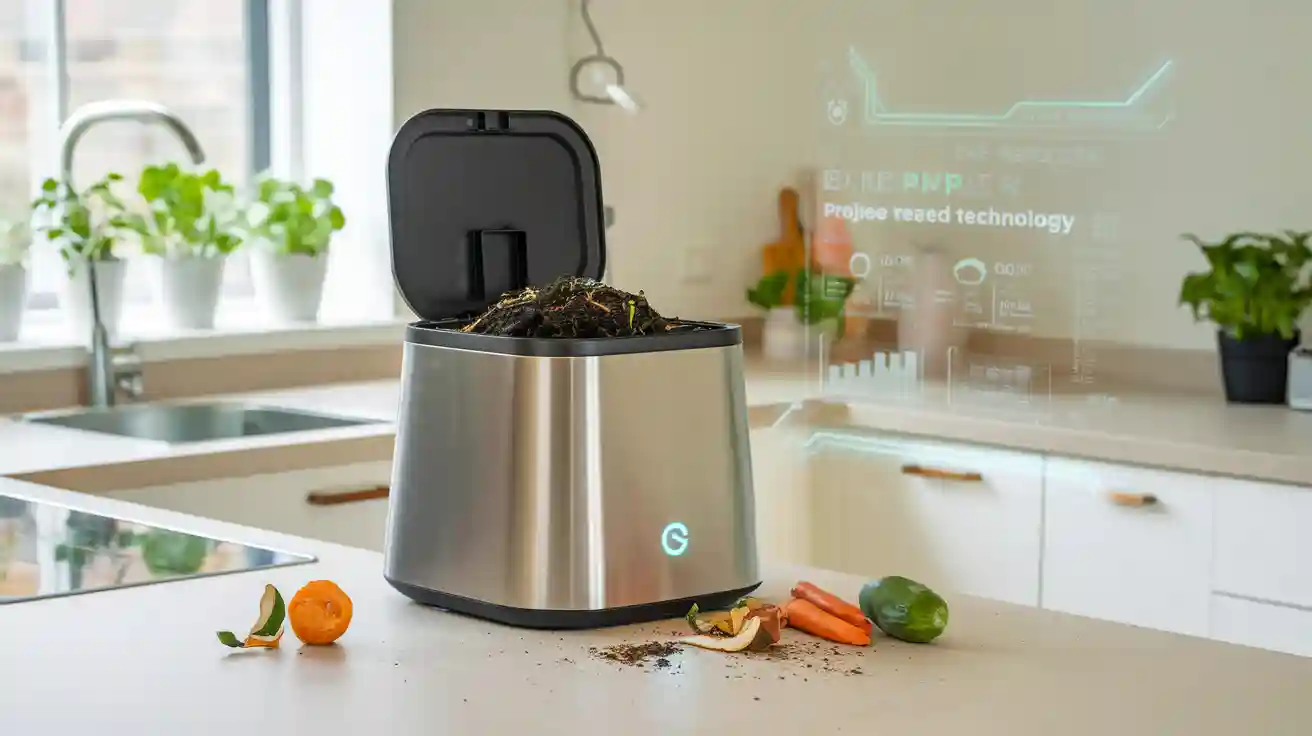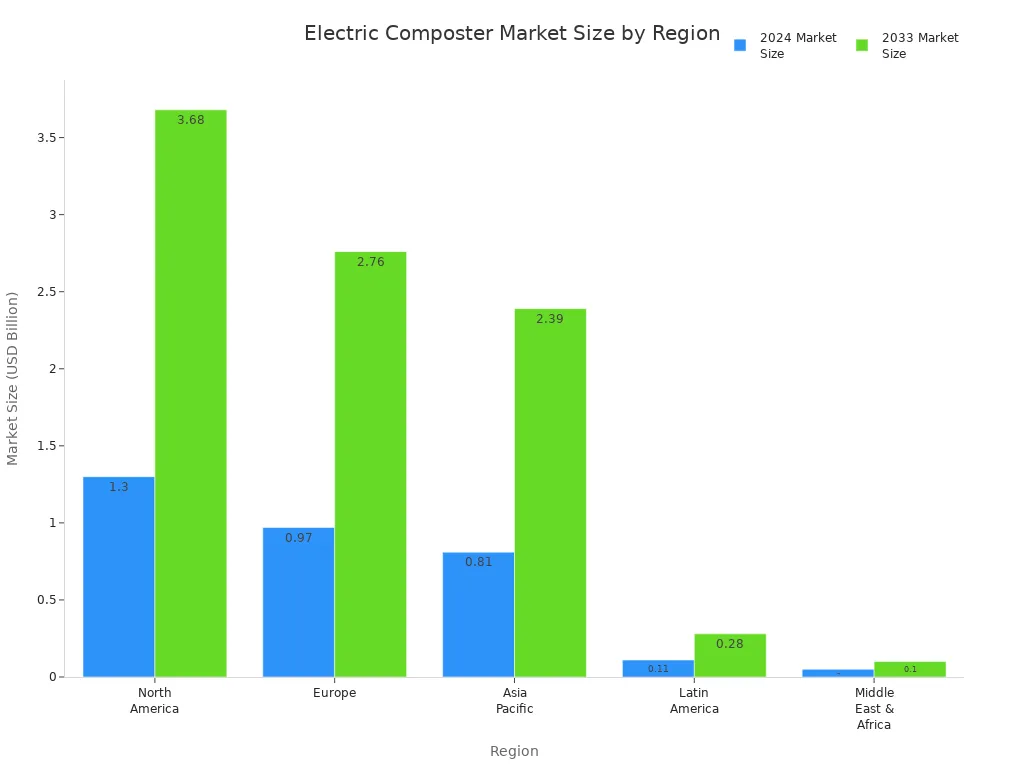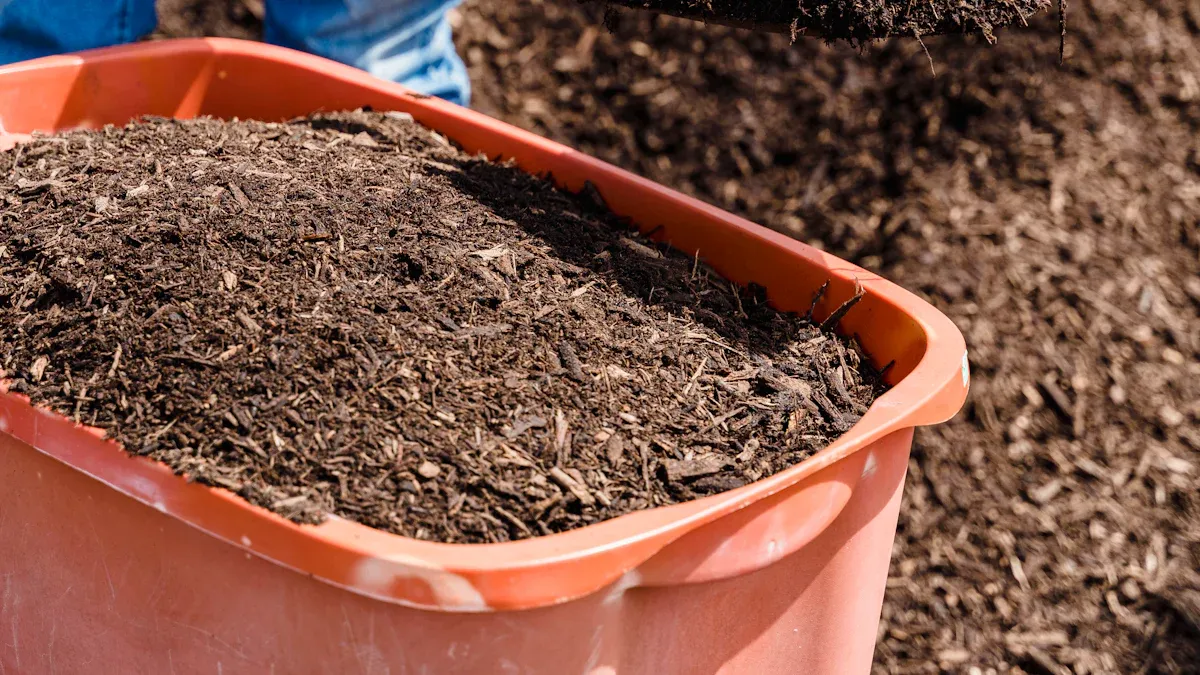
Real electric composters deliver practical solutions that many once thought possible only in science fiction. Devices like the electric composter icarus inspired imagination, but real products now make composting faster and easier for families. Global adoption has soared, with Asia Pacific leading growth due to urbanization and environmental awareness.

The composter market reached $1.2 billion in 2024 and is set to triple by 2033. Many households now rely on a composter to manage food waste efficiently.
Electric Composter Icarus vs. Real Electric Composters
Science Fiction Composting: The ICARUS Example
The electric composter icarus often appears in science fiction stories as a device that transforms waste into rich soil in seconds. In these tales, the composter icarus uses advanced technology that seems almost magical. People imagine a machine that never smells, never needs cleaning, and works instantly. The electric composter icarus promises a future where composting becomes effortless and invisible.
Many readers picture the electric composter icarus as a sleek, silent box that takes any kind of waste and produces perfect compost with no effort. This vision sets high expectations for real-world composters.
Science fiction often skips over the real challenges of composting. It ignores the need for air, heat, and helpful microbes. The electric composter icarus in these stories does not show the real process of breaking down food scraps. Instead, it creates a fantasy of instant results and zero mess.
Real-World Innovations and Capabilities
Real electric composters have made huge progress in recent years. They do not work like the electric composter icarus from science fiction, but they offer many smart features that make composting easier for families.
- True aerobic composting uses automatic turning and special microbes to break down food waste, just like in nature.
- Advanced temperature control and strong air exchange help speed up the composting process.
- Powerful odor filters remove smells without needing frequent filter changes.
- Intelligent systems give reminders when the compost is ready, when the composter is too full, or when safety locks are needed.
- Compact designs fit on kitchen counters or small floors, making composting possible even in tiny homes.
- Unlike simple food dehydrators, these electric composters create real compost that can be used as fertilizer.
Some models use two chambers to shred and dry kitchen waste automatically. Sensors track temperature, humidity, and airflow to help microbes work faster. A water recycling system collects and reuses water from the waste, saving resources. Heat exchange systems reuse heat from the composting process, making the composter more energy efficient. Multi-stage carbon filters and vacuum technology keep kitchens odor-free. Many electric composters now connect to smartphone apps, so users can monitor and control the process from anywhere.
Recent improvements include better motors and temperature controls that make composting faster. Apps help users adjust settings, prevent odors, and get alerts when the compost is ready. These features make electric composters easy to use, even for people with little space or technical skill.
Real electric composters may not match the instant magic of the electric composter icarus, but they offer practical solutions that bring the dream of easy composting closer to reality.
How Electric Composters Work
Core Technology and Process
Electric composters use science to speed up the composting process. These machines rely on aerobic composting, where bacteria and fungi break down food scraps in the presence of oxygen. The composter keeps the right balance of air, heat, and moisture. This helps microbes work quickly and prevents bad smells. Research shows that electric composters reduce the volume of food waste fast by using electricity to power heating, grinding, and stirring. The process often includes three main steps:
- The machine heats food scraps to about 160 degrees Fahrenheit. This kills germs and dries the waste.
- It grinds the dried food into small pieces.
- The composter cools the material before users remove it.
Unlike outdoor piles, these devices focus on rapid volume reduction. The output may look like dehydrated food waste and sometimes needs more time to become rich compost.
Electric composters avoid foul odors and methane by keeping the process aerobic and controlled.
Key Features in Modern Devices
Modern electric composters offer many features that make composting easy for families. Most models work automatically and need little maintenance. They handle all types of food waste, including meat and dairy, which traditional composting cannot process safely. Key features include:
- Odor control with carbon filters for odorless operation
- Removable, dishwasher-safe buckets for easy cleaning
- Fast processing times, often around three hours
- Compact designs for kitchen counters
- Smart sensors that monitor temperature, moisture, and airflow
- App controls for remote monitoring and scheduling
Smart sensors and automation help the composter adjust settings in real time. This improves efficiency, saves energy, and ensures the composting process runs smoothly. Some machines even use machine learning to predict when compost is ready, making the process simple and reliable.
Electric Composters: Promises vs. Reality
Marketing Claims and Misconceptions
Manufacturers often promote their products as high-tech solutions for kitchen waste. Many call their devices “kitchen composters” or “countertop composters” and claim they turn food scraps into compost or soil-like material. Some companies, such as Lomi and FoodCycler, use words like “compost” or “soil” in their advertising, even though the output is not true compost. Mill, another brand, avoids the word “compost” and instead calls its product “Food Grounds,” offering a service to repurpose the byproduct as chicken feed.
Companies highlight benefits such as odor-free operation, mess-free cleanup, and easy waste reduction. They often mention environmental advantages and claim their machines help lower the carbon footprint.
However, these claims can mislead buyers. The output from most electric composters is not true compost. Instead, it is dehydrated food waste that has not fully broken down. Some advertisements suggest the product supports plant growth, but experts warn that the byproduct may harm plants if used directly. High salt content and incomplete decomposition can disrupt soil balance and even attract pests. Some brands also claim their machines can compost bioplastics, but this process requires industrial facilities, not home appliances.
Common misconceptions found in advertising include:
- The belief that the machine produces real compost or soil, when it actually creates dried kitchen scraps.
- The idea that the product is always safe for plants, even though it may contain harmful salts.
- The suggestion that the device can compost bioplastics, which is not possible in a home setting.
- The claim that the process eliminates all odors and pests, while some users still report issues.
What You Actually Get
When families use electric composters, they often notice a gap between marketing promises and real results. The machines do reduce the volume and weight of food waste, but the output is not finished compost. Instead, users receive a chunky, fibrous material that looks like dried food scraps. This byproduct may need further composting before it becomes safe and useful for plants.
The table below compares marketing promises with real-world results:
| Aspect | Marketing Promise | Real-World Result |
|---|---|---|
| Composting Process | Produces true compost quickly and efficiently | Dries and grinds food waste; output is dehydrated, not stable compost. |
| Output Quality | Finished compost suitable as fertilizer | Output is not fully broken down; may harm plants if used directly. |
| Temperature | Runs hot to aid composting | High heat kills microbes; composting does not occur. |
| Grinding Capability | Effectively grinds food waste | Blades are often blunt; large pieces remain. |
| Volume and Weight Reduction | Claims up to 90% reduction | Actual reduction is closer to 75%, mostly from water loss. |
| Environmental Impact | Eco-friendly by reducing landfill waste | Only eco-friendly if output avoids landfill; dried waste still produces methane if landfilled. |
| Energy Use | Not typically addressed | Uses about 1 kWh per cycle; filter replacements add to environmental cost. |
| Manufacturer Claims | Composting proof provided | Most admit to only dehydrating food waste, not true composting. |
Performance metrics from users show that these machines reach high temperatures, reduce water content, and lower the weight of waste. For example:
- Highest temperature: 76°C (about 169°F)
- Water content reduction: 16.76%
- Organic matter reduction: 4.90%
- Weight reduction rate: 35.45%
These numbers show that electric heating helps dry and shrink food waste, but does not complete the composting process. The output may still contain concentrated nutrients and salts, which can harm plants if used without further treatment.
Electric composters help reduce food waste volume and make composting more accessible, but they do not replace traditional composting methods. People with access to outdoor composting or city compost programs may find limited benefits from these machines.
Performance Comparison: Electric vs. Traditional Composting

Speed and Convenience
Electric composters process food waste much faster than traditional composting methods. Most electric models can break down kitchen food waste in as little as 4 to 24 hours. Some, like the Karfo composter, offer a quick mode that starts decomposition in just 2.5 hours. In contrast, traditional composting often takes several months to a year to fully break down food waste. Hot composting methods can speed up the process to about 18 days, but these require frequent turning and careful moisture control.
| Composting Method | Typical Duration | Key Points |
|---|---|---|
| Traditional Natural | Several months to a year | Slow, needs little management |
| Hot Composting (Berkeley) | About 18 days | Needs frequent turning, moisture control |
| Electric Composters | 4 to 24 hours | Fast, easy, fits busy lifestyles |
Electric composters also offer more convenience. They fit on kitchen counters and work well in small spaces. Most models run automatically and need only occasional cleaning or filter changes. Traditional composting needs outdoor space, regular turning, and close monitoring. Electric composters save time and effort, making them ideal for busy families.
Output Quality and Usability
The output from electric composters looks different from traditional compost. Electric composters produce a dry, fibrous material in hours. This material often needs more time to mature before it becomes true compost. Traditional composting creates rich, dark compost that is ready to use in gardens after several months.
| Aspect | Traditional Composting | Electric Composters |
|---|---|---|
| Processing Time | Weeks or months | Hours or days |
| Required Space | Needs outdoor area | Compact, fits indoors |
| Maintenance | Regular turning, monitoring | Minimal effort, mostly automated |
| Odor Control | Can produce odors | Good odor control, suitable for indoor use |
| Convenience | More hands-on | Easy to use, plug-and-play |
| Cost | Low, no electricity | Higher upfront cost, uses electricity |
Electric composters handle all types of kitchen food waste, including items that traditional composting cannot process easily. They control odors well, making them suitable for indoor use. However, the byproduct may need further composting before it is safe for plants. Traditional composting produces higher-quality compost but takes more time and effort.
Environmental Impact and Practical Benefits
Energy Consumption and Efficiency
Electric composters use electricity to process food waste, but their energy consumption stays low compared to many household appliances. Most models use between 0.5 and 1.5 kWh per cycle. For example, the Lomi composter uses less than 0.60 kWh in Eco mode and about 1.0 kWh in Grow mode. The Vitamix FoodCycler uses around 0.8 kWh per cycle, while the Mill composter averages 0.7 kWh per day. The table below shows typical energy use:
| Model/Mode | Energy Consumption per Cycle (kWh) |
|---|---|
| Lomi Eco mode | < 0.60 |
| Lomi Grow mode | ~1.0 |
| Vitamix FoodCycler | ~0.8 |
| Mill Composter (daily use) | ~0.7 |
When compared to other kitchen appliances, electric composters use energy similar to a slow cooker or dehydrator. For instance, the Lomi costs about $100 per year to run, while the Reencle model uses about $24 worth of electricity annually. Many models include energy-saving features, making them efficient choices for homes.
Waste Reduction and Sustainability
Electric composters help families tackle the food waste problem by keeping food scraps out of the landfill. The average person throws away about 238 pounds of food waste each year. A food waste recycler like the Mill machine can divert 20 pounds of food waste in less than two weeks and up to 80 pounds in six weeks. Over a year, this means a household can keep a large portion of its food waste from reaching the landfill.
- Electric composters reduce methane emissions by keeping food waste out of the landfill.
- They prevent anaerobic decomposition, which produces methane, a strong greenhouse gas.
- Composting at home can save hundreds of pounds of CO2 equivalent emissions each year.
- The compost produced can enrich soil and reduce the need for chemical fertilizers.
Sending food waste to the landfill creates about 0.52 tons of CO2 emissions per ton of waste. Composting at home drops this to only 0.02 tons. For a family of four, using an electric composter can prevent about 438 pounds of CO2 emissions each year. This shows that electric composters make a real difference in fighting the food waste problem and supporting a more sustainable lifestyle.
Limitations of Electric Composters
Byproduct Quality and Application
Electric composters promise quick results, but the quality of their output often falls short. Many devices produce dehydrated food waste instead of true compost. This material lacks the microbial stability found in traditional compost. Users often report several issues with the byproduct:
- Mold can grow on the output, especially if stored in a humid place.
- Flies and other pests may be attracted to the dried food waste.
- Strong, unpleasant odors sometimes develop, making indoor use difficult.
- Plant growth tests show poor results. Seeds may not sprout, and some plants die when using the byproduct as a soil amendment.
- The chemical makeup of the output often includes high salt levels, low moisture, and unsuitable pH values.
- Some byproducts need extra steps, like washing, before they are safe for gardens.
- Marketing terms like “compost” or “food residue” can confuse buyers about what the product really is.
Despite these problems, some electric composters, such as the Neakasa Moreborn, use heat and bacteria to create a more complete compost. When the process works well, the output can improve soil health and reduce the need for chemical fertilizers. However, not every kitchen composter produces this level of quality.
Cost, Maintenance, and Usability
Electric composters offer convenience, but they come with costs and challenges. The initial price can be high compared to traditional compost bins. Users must also pay for electricity and replacement filters. Maintenance includes cleaning the machine and emptying the byproduct regularly.
Common usability issues include:
- Confusing marketing claims about the output.
- Odors and mold from incomplete composting.
- Negative effects on indoor plants when using the output directly.
- Most devices only remove moisture from food waste, so further composting may be needed.
- High salt content and pH problems can harm plant growth.
- Lack of industry standards leads to mixed results and consumer confusion.
Some users find that the output attracts pests or smells bad if not handled properly. Experts like Professor Sally Brown note that these machines do not make true compost. Brands such as Lomi and FoodCycler admit their products differ from real compost, which can disappoint buyers.
Real Experiences with Electric Composters
User Reviews and Feedback
People who use electric composters often share their experiences online. Many highlight the benefits these machines bring to daily life:
- Odor-free operation keeps kitchens smelling fresh.
- Pest-free design prevents unwanted insects.
- Compact size fits well in small kitchens or pantries.
- Automatic operation makes composting easy for everyone.
- Some models, like Reencle, run quietly and produce nutrient-rich compost quickly.
However, users also mention some drawbacks. They notice that compost quality can vary between models. Some machines create rich soil, while others leave behind dry mulch. Many users appreciate the efficiency and environmental benefits, but they remain cautious about the cost, space needed, and higher energy bills. Long-term reliability is another concern, as electric composters are still a new technology.
The table below compares user satisfaction between electric and traditional composters:
| Aspect | Electric Composters | Traditional Composters |
|---|---|---|
| Convenience | High, easy to use, fits on counters | Less convenient, more effort required |
| Waste Processing | Selective, needs sorting | Accepts more waste, slower process |
| Reliability | Some technical issues reported | Durable, but sometimes weak materials |
| Odor & Pest Control | Generally good, but can vary | Often praised for pest resistance |
| Satisfaction Focus | Automation, eco-friendly | Robustness, sustainability |
Expert Insights and Analysis
Industry experts see both strengths and weaknesses in electric composters. They praise advanced features like smart sensors, multiple processing modes, and strong odor control. Machines such as Mill handle a wide range of food waste, including meat and dairy, while compact models like Lomi suit smaller households.
Experts recommend that buyers:
- Choose a composter size that matches their kitchen space and family needs.
- Look for strong odor control, such as carbon filters.
- Consider safety features like child locks for families.
- Understand that electric composters produce dried, ground food waste, not traditional compost.
- Avoid putting hard items or liquids in the machine to prevent damage.
Experts agree that electric composters reduce food waste and carbon emissions. However, they remind consumers that these machines do not fully replace traditional composting. Users should balance convenience, cost, and their household’s needs when selecting a model.
- Real electric composters now offer speed and convenience that often surpass science fiction dreams.
- These devices help families reduce waste and support sustainable living.
Before buying, readers should compare features, costs, and their own needs. Careful research leads to better choices and greater satisfaction.
FAQ
How long does it take for an electric composter to process food waste?
Most electric composters finish a cycle in 4 to 24 hours. The exact time depends on the model and the amount of waste.
Can the output from electric composters go directly into a garden?
The byproduct often needs more composting before use in gardens. High salt levels or incomplete breakdown can harm plants if used right away.
Do electric composters handle all types of food waste?
Many models accept fruits, vegetables, meat, and dairy. Hard bones, large pits, and liquids may cause problems or damage the machine.
Tip: Always check the manufacturer’s guidelines for best results and safe operation.


